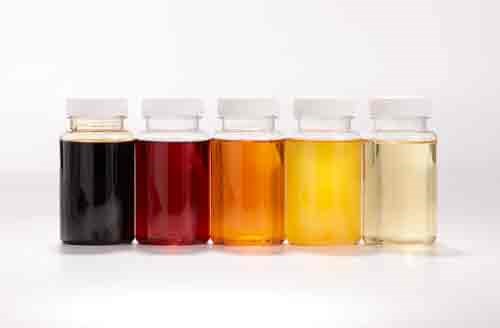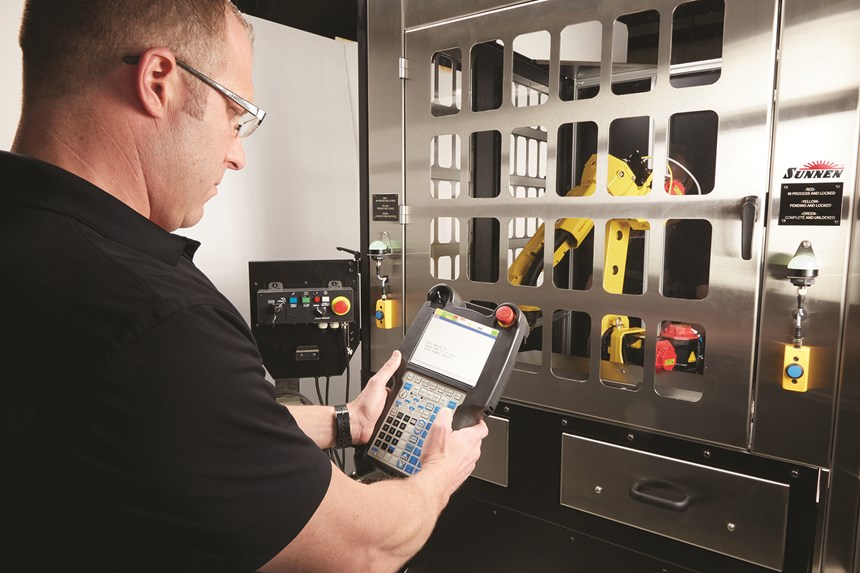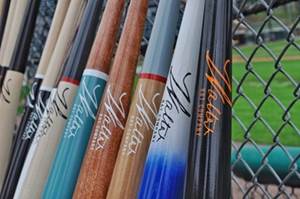The success of the honing process depends on the precise performance of each of five key components of the honing system: the machine, fixturing, tooling, abrasive and honing oil. Even though honing oil accounts for around one percent of the total process cost, selecting the right honing oil has a direct and immediate impact on abrasive consumption, labor, cycle times and quality.
When the right honing oil is left out of the equation, it will definitely lead to reduced production and increased costs. The wrong oil could drastically increase cycle times by adversely affecting metal removal rates by 50 percent or more and reduce abrasive life by 30 percent or more. Selecting the wrong oil will also drive up scrap costs because of missed tolerances and poor surface finishes.
Specialty Lubricity Agents and Additives
Honing oils and lubricants serve several important purposes in the honing process. They reduce friction and thus heat, which can cause major problems during honing such as welding and decreased abrasive life. They also wash away the chips or swarf from the surface of the workpiece during honing, which brings new abrasive grit to the surface of the stone to maintain optimum abrasive cutting action.
Chemical activity is another important reason for using a top-quality honing fluid. A good honing fluid must not corrode the workpiece, but stay in contact with the workpiece surface and provide lubricity even as temperature and pressure rise.
At the abrasive cutting tip, the temperature comes close to the melting point of the metal being honed. This high temperature occurs in microscopic spots at the points of cutting action, and without proper lubricant, would result in welding of the metal guide shoe to the metal being honed. These tiny weld spots would be torn apart by the force of the honing machine, and the results would be a rough surface finish and the rapid wear of the honing stone and guide shoe. However, a capable, formulated “coolant” will prevent welding by chemically changing the hot spots from high friction metal to a non-metallic, slippery compound, which will resist welding. This welding problem is especially likely to happen with high-alloy materials, such as stainless steel.
High performance anti-weld additives, such as sulfur, chlorine and phosphorous, are sometimes employed to prevent welding of the chips and workpiece material. Micro welding can produce scratches in the bore and damage the abrasive and tooling. Lubricity additives keep the abrasive clean. Different honing oils are available with various levels of additives to meet the individual application needs. Formulated honing oils are specifically designed to deliver the fastest stock removal rates with the lowest abrasive consumption, while delivering the required accuracies and surface finishes, all with the desired effect of delivering the lowest cost per part.
Low Performance Honing Oil Problems
One sign of poor oil performance is a variation of the stone wear ratio. That is, the number of parts honed per abrasive stone used. The ratio of abrasive used to stock removal is dependent on many factors such as a starting surface finish, material honed, honing pressure, surface speed and operator technique, but should always be consistent, part to part.
In a production environment where the same parts are honed one after another, the stone wear ratio should be very stable, reflecting the consistent bond structure of a quality honing abrasive. If the honing oil does not adequately lubricate the honing chip and grit, the abrasive grain wear will become erratic. This will affect the stone wear ratio and cause the finished part size to vary unless in-process gaging is used to stop the honing cycle.
Low performance honing oil allows welding of metal chips to the workpiece, which are then sheared off, causing a larger total surface roughness than expected for a given abrasive grit size. The consequence is unwanted random scratches on the workpiece deeper than those normally produced during honing operations. The results are lost productivity, material waste, part rejects and lost profit.
Metal specks in the abrasive surface are a sign of honing oil with low lubricity. The oil fails to fully lubricate allowing chips to lodge into the abrasive surface. The embedded chips will hold the abrasive away from the workpiece and prevent uniform grit penetration into the base metal, preventing material removal. The metal carried in the abrasive surface can scratch or tear the honed surface as the abrasive sweeps the chips along the honing tool path. If this “loading” of the abrasive surface is minor, it may go unnoticed, however, productivity will begin to drop off. When the loading is more severe, it leads to fracture of the abrasive. The trapped chips are forced against the part wall by the honing stone. If the chip re-welds to the part, it can scratch or chip the honing stone.
When embedded metal that is near the leading edge of the abrasive welds to the workpiece, the abrasive is loaded in compression and will seldom break. Instead, the welded metal cuts a groove in the abrasive. If embedded metal that is near the trailing edge of the abrasive re-welds to the workpiece, the abrasive has less support to resist the tearing motion and will break away, leaving a chip on the trailing edge.
Low performance honing oil can create catastrophic welding between the workpiece and the mandrel shoe when honing soft materials ranging from stainless steel to low carbon steels. This may lead to serious and costly problems such as ruined honing tools and machine failure. When the lubricant film separating the mandrel and workpiece fails, the mandrel can weld to either the workpiece or the chips, leaving severe scratches on the mandrel and part, or worse—a broken tool.
A common myth is that honing tools without guide shoes are immune to welding problems. This is not true, and in fact, it’s a sure sign of a honing fluid problem. If the honing fluid fails, it will permit stone loading, where metal chips created by the cutting action of the honing stones stick to the stone surface. When stone loading occurs, there will be metal-to-metal contact and welding, with the same undesirable results as when using a honing tool with metal guide shoes. The cost of broken tools can quickly overtake the savings found with inferior honing fluids.
The use of quality honing oil allows the use of higher honing pressures without experiencing welding of the tooling or workpiece chips. No matter what, reduction of friction in the honing process always improves the bottom line, whether it be cost/part, cycle time, abrasive consumption or any other measure of merit.
Selecting the Right Honing Fluid for the Application
There is a honing fluid formulated for almost every material used in manufacturing, from aluminum to zirconium. Choices include petroleum or organic oil-based honing and superfinishing fluids and synthetic/semi-synthetic, water-based fluids.
Selecting the right honing fluid is mostly application driven based on restrictions, the material being honed and the tooling used. The presence of restrictions or special requirements limit the available choice of honing oils. There are special honing oil formulations that conform to Food and Drug Administration (FDA) and European Commission guidelines and regulations applicable to honing medical devices that will be implanted into the human body.
Aerospace companies often have lists of approved honing oils used for honing critical parts. Vendors are required to use only honing oils on the approved list. These are products that have undergone rigorous testing to ensure the part experiences no harm, such as inner granular corrosion that could lead to part failure in the future.
The nuclear industry often dictates the allowable levels of sulfur, chlorine and fluorine in honing oil used. Additional restrictions often apply regarding levels of arsenic, bismuth, antimony, silver, mercury, cadmium, gallium, indium, lead, tin or zinc beyond trace levels. Honing oil formulations are available to meet these requirements. These are lubricants composed entirely of surface active lubricity agents formulated to a suitable viscosity. Because this type of product does not use additives, it is ideally suited for applications where additives are restricted.
In job shop environments, where a variety of parts may be processed daily, MB-30 honing oil is known in the market as a general, all around honing oil. It can be used with most types of tooling, abrasives and workpiece materials and is typically non-toxic or irritating to the skin or eyes. Disposal is simplified because MB-30 does not contain chlorine or other materials that are restricted by the Environmental Protection Agency (EPA).
The number of applications, materials and industries varies, as well as oils and lubricants available for the job. When trying to determine the best honing oil for an application, consult the honing experts first for advice in selecting the best, premium oil for an application.
Material Type
Honing oil must meet the lubrication demands of the material being honed. Difficult materials such as stainless steel require higher levels of surface active lubricity agents than easier materials such as cast iron, which is somewhat self-lubricating and gall resistant. Materials that form short, flakey chips such as carbide, glass or ceramic require less lubricity than those that form long, stringy chips such as aluminum. Consideration must be given to staining and discoloration of the parts when honing nonferrous metals. One remaining factor is the yield strength of the workpiece material. Strong materials such as tool steel will require higher honing forces on the abrasive to cut properly. These higher loads place increased demands for lubrication from the honing oil.
The type of abrasives being used is another consideration when selecting the right lubricant, whether conventional abrasives, metal bond superabrasives or plated diamond tools. Full service suppliers such as Sunnen Products have more than 20 different types of preformulated honing oils and lubricants that will match with its line of abrasive tools.
Generally, the use of conventional abrasive with traditional honing mandrels (that have a guiding shoe surface) place the greatest demands on the honing oil. Requirements are diminished for honing units where only abrasive touches the bore with metal bond being more tolerant than conventional abrasive. Superabrasive plated tools appear to be most tolerant of honing oil performance. All metal bond and superabrasive plated tools are often used with water-based coolant.
Social Responsibility
Chemistry plays a big role in not only how a lubricant performs, but also how its handled. Like all cutting oils, depending on the chemical makeup, honing lubricants can be regulated by Occupational Safety and Health Administration (OSHA), the Department of Transportation (DOT) on how it’s shipped, the U.S. Department of Agriculture (USDA) and the EPA on how it’s used and disposed of. The chemical composition of each lubricant is also scrutinized by industry.
The latest developments in honing oil technology can now deliver renewable/sustainable honing oil that is clean, green and 100 percent vegetable-based. These oils are popular in Europe and growing in popularity in the U.S.
Important Details
Most honing machines use a filtration system to keep the oil clean. When petroleum-based honing oil is protected from pollution and properly filtered, “carry-off” becomes the biggest factor in honing oil usage. Carry-off is the amount of oil that sticks to the part during honing and is normally washed off the part after machining.
Small parts have little carry-off, and a 55-gallon drum might last a year or more. Large parts with more surface area will contribute to more carry-off. Subsequently, the system’s oil reservoir will need to be replenished more often.
Oil viscosity plays a role as thicker oils will increase carry-off. Carefully matching the honing process requirements in consideration of the honing oil viscosity will help reduce the amount of oil lost to carry-off. In general, the higher the production volume, the more carry-off is to be expected. These losses are reduced if drainage time is increased, but this is seldom possible in a high production environment. Some users are known to use centrifuges to quickly remove oil from finished parts. Such steps also reduce the burden of subsequent cleaning processes.
Petroleum-based honing oils generally have a much longer shelf life than organic oils, which are formulated using base oils from plant or animal sources. Users who favor the organic-based oils are wise to avoid excessive storage and make frequent purchases to always have the “freshest” product available.
The service life of petroleum-based oil in the honing machine is long, providing the oil is kept clean by filtering and not polluted by extraneous, harmful materials. This statement can be understood when the absence of high operating temperatures or pollution by combustion products occurs in compressors or engines are considered.
Conversely, the service life of organic-based honing oils is limited by chemical activity, which changes the chemistry of the oil itself. These changes are delayed by protective additives and promoted by exposure to air. The service life is largely influenced by the temperature at the honing stone—part interface, not the bulk oil temperature.
There are newly formed chemicals that thicken the oil and can have a positive effect on honing lubrication. The bad effects are the formation of varnishes that are difficult to clean from parts. Note that the transformed honing oil remains in the machine reservoir as fresh make up oil is added to compensate for carry off. Therefore, at some point in time, the entire system must be discarded and recharged with new.
Honing oil is often purchased in 55-gallon drums, 330-gallon returnable totes, or smaller 5-gallon pails. The use of a honing oil concentrate that is blended with base oil on site offers an alternative method of obtaining certain regular-strength honing oils. Concentrates are also useful to salvage existing petroleum-based honing fluids in the event that more lubrication is required, by making additions that boost performance rather than discarding the existing oil and replacing it with new oil.
Value Proposition
Operators are often astonished to find a drastic increase in abrasive life when changing to a premium honing oil. The extra investment made in honing oil that results in reduced abrasive consumption will generally pay for itself many times over. A good quality honing oil will allow the use of higher cutting pressures resulting in faster stock removal. A one-percent increase in stock removal rates translates into a one-percent decrease in total labor costs. When the cost of scrap is considered, the wisdom of using quality honing oil is clear.
A barrel of premium grade honing oil may cost twice as much as a barrel of oil not formulated for honing. However, the real value is found in honing oil that will produce parts to specifications at the lowest overall honing cost per part. Even the slightest decrease in cycle time or a decrease in abrasive consumption resulting from a better lubricant repays the cost of premium honing oil many times over. To achieve optimal results, don’t cheap out when it comes time to buy honing oil. Its more specialized than expected.
Related Content
When a CNC Turn-Mill Doesn’t Turn
A shop in Big Sky Country uses a B-axis multitasking machine to produce complex, prismatic medical parts that require no turning complete from barstock.
Read MorePursuit of Parts Collector Spearheads New Enterprise
While searching for a small parts accumulator for Swiss-type lathes, this machine shop CEO not only found what he was looking for but also discovered how to become a distributor for the unique product.
Read MoreCraftsman Cribsheet No. 128: Why Do Machinists Say Tenths Instead of Ten Thousandths?
In machinist parlance, a tenth is a tenth of a thousandth, not a tenth of an inch.
Read MoreVideo: Why a Production Machine Shop Started a Baseball Bat Company
A 153-year-old manufacturer of precision, metal pins recently started a side business creating custom wooden baseball bats. The reasoning behind establishing this new company is intriguing, as is how it has helped create a stronger bond with the local community.
Read MoreRead Next
5 Aspects of PMTS I Appreciate
The three-day edition of the 2025 Precision Machining Technology Show kicks off at the start of April. I’ll be there, and here are some reasons why.
Read MoreDo You Have Single Points of Failure?
Plans need to be in place before a catastrophic event occurs.
Read MoreA Tooling Workshop Worth a Visit
Marubeni Citizen-Cincom’s tooling and accessory workshop offers a chance to learn more about ancillary devices that can boost machining efficiency and capability.
Read More











.png;maxWidth=300;quality=90)













